Comprehensive Report: Dietary Requirements and Nutritional Analysis
VerifiedAdded on 2022/11/25
|12
|2443
|121
Report
AI Summary
This report provides a comprehensive overview of dietary requirements, covering various aspects such as the Eatwell guide, nutritional needs of different groups (pregnant women, children, and the elderly), and the role of macronutrients. It discusses the evolution of dietary guidelines, including the COMA and SACN reports, and explains Dietary Reference Values (DRVs) and their application. The report also delves into the normal distribution of nutritional requirements, the importance of basal metabolic rate, and the current UK guidelines for macronutrient intake. Furthermore, it examines specific nutrients like essential fatty acids, proteins, and carbohydrates, along with their impact on health, and concludes with a brief comparison of alcohol consumption guidelines across different regions. The report is well-researched, referencing several online sources to support its findings.

Dietary Requirement
Paraphrase This Document
Need a fresh take? Get an instant paraphrase of this document with our AI Paraphraser

Table of Contents
INTRODUCTION...........................................................................................................................3
MAIN BODY...................................................................................................................................3
CONCLUSION................................................................................................................................8
REFERENCES................................................................................................................................1
INTRODUCTION...........................................................................................................................3
MAIN BODY...................................................................................................................................3
CONCLUSION................................................................................................................................8
REFERENCES................................................................................................................................1
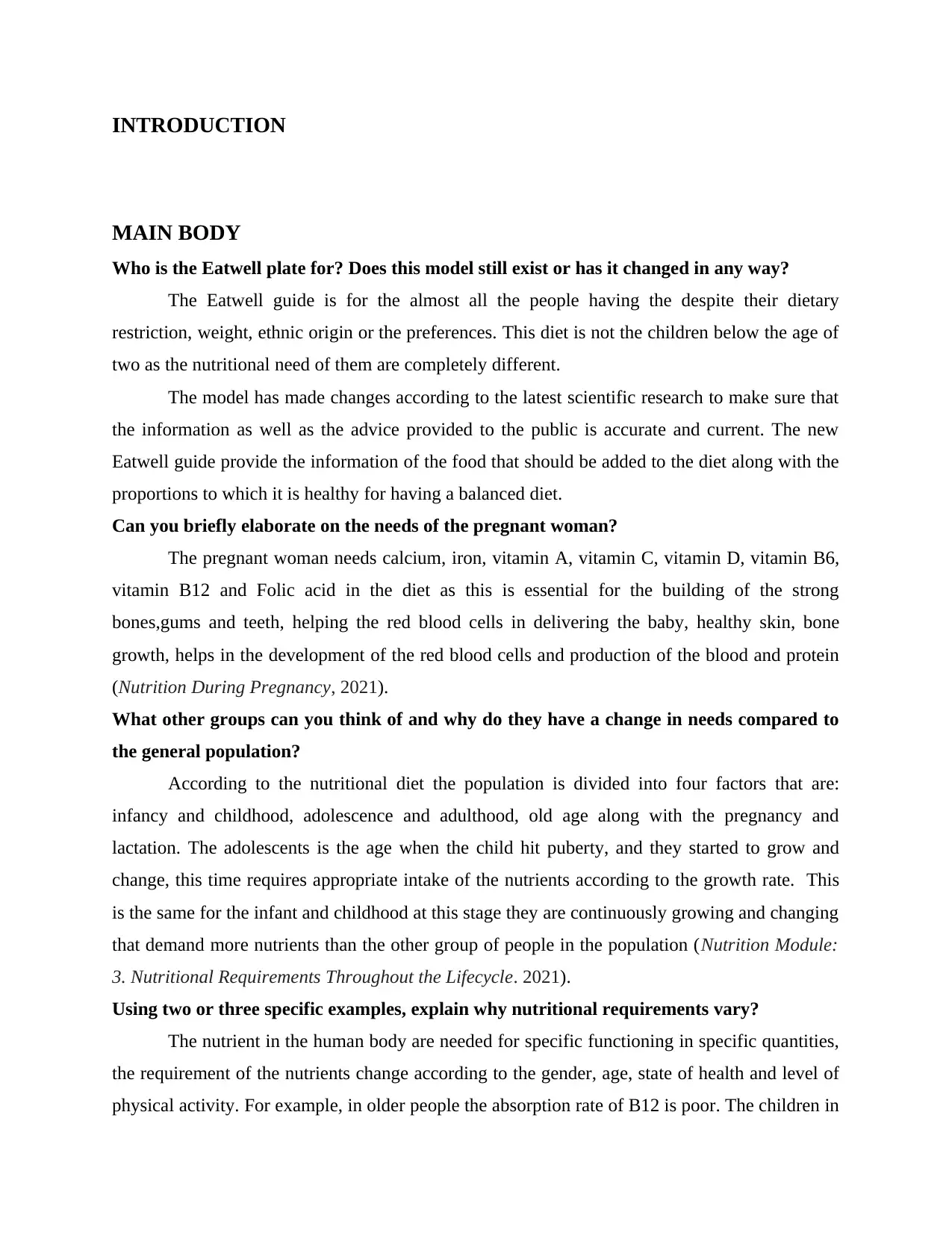
INTRODUCTION
MAIN BODY
Who is the Eatwell plate for? Does this model still exist or has it changed in any way?
The Eatwell guide is for the almost all the people having the despite their dietary
restriction, weight, ethnic origin or the preferences. This diet is not the children below the age of
two as the nutritional need of them are completely different.
The model has made changes according to the latest scientific research to make sure that
the information as well as the advice provided to the public is accurate and current. The new
Eatwell guide provide the information of the food that should be added to the diet along with the
proportions to which it is healthy for having a balanced diet.
Can you briefly elaborate on the needs of the pregnant woman?
The pregnant woman needs calcium, iron, vitamin A, vitamin C, vitamin D, vitamin B6,
vitamin B12 and Folic acid in the diet as this is essential for the building of the strong
bones,gums and teeth, helping the red blood cells in delivering the baby, healthy skin, bone
growth, helps in the development of the red blood cells and production of the blood and protein
(Nutrition During Pregnancy, 2021).
What other groups can you think of and why do they have a change in needs compared to
the general population?
According to the nutritional diet the population is divided into four factors that are:
infancy and childhood, adolescence and adulthood, old age along with the pregnancy and
lactation. The adolescents is the age when the child hit puberty, and they started to grow and
change, this time requires appropriate intake of the nutrients according to the growth rate. This
is the same for the infant and childhood at this stage they are continuously growing and changing
that demand more nutrients than the other group of people in the population (Nutrition Module:
3. Nutritional Requirements Throughout the Lifecycle. 2021).
Using two or three specific examples, explain why nutritional requirements vary?
The nutrient in the human body are needed for specific functioning in specific quantities,
the requirement of the nutrients change according to the gender, age, state of health and level of
physical activity. For example, in older people the absorption rate of B12 is poor. The children in
MAIN BODY
Who is the Eatwell plate for? Does this model still exist or has it changed in any way?
The Eatwell guide is for the almost all the people having the despite their dietary
restriction, weight, ethnic origin or the preferences. This diet is not the children below the age of
two as the nutritional need of them are completely different.
The model has made changes according to the latest scientific research to make sure that
the information as well as the advice provided to the public is accurate and current. The new
Eatwell guide provide the information of the food that should be added to the diet along with the
proportions to which it is healthy for having a balanced diet.
Can you briefly elaborate on the needs of the pregnant woman?
The pregnant woman needs calcium, iron, vitamin A, vitamin C, vitamin D, vitamin B6,
vitamin B12 and Folic acid in the diet as this is essential for the building of the strong
bones,gums and teeth, helping the red blood cells in delivering the baby, healthy skin, bone
growth, helps in the development of the red blood cells and production of the blood and protein
(Nutrition During Pregnancy, 2021).
What other groups can you think of and why do they have a change in needs compared to
the general population?
According to the nutritional diet the population is divided into four factors that are:
infancy and childhood, adolescence and adulthood, old age along with the pregnancy and
lactation. The adolescents is the age when the child hit puberty, and they started to grow and
change, this time requires appropriate intake of the nutrients according to the growth rate. This
is the same for the infant and childhood at this stage they are continuously growing and changing
that demand more nutrients than the other group of people in the population (Nutrition Module:
3. Nutritional Requirements Throughout the Lifecycle. 2021).
Using two or three specific examples, explain why nutritional requirements vary?
The nutrient in the human body are needed for specific functioning in specific quantities,
the requirement of the nutrients change according to the gender, age, state of health and level of
physical activity. For example, in older people the absorption rate of B12 is poor. The children in
⊘ This is a preview!⊘
Do you want full access?
Subscribe today to unlock all pages.

Trusted by 1+ million students worldwide
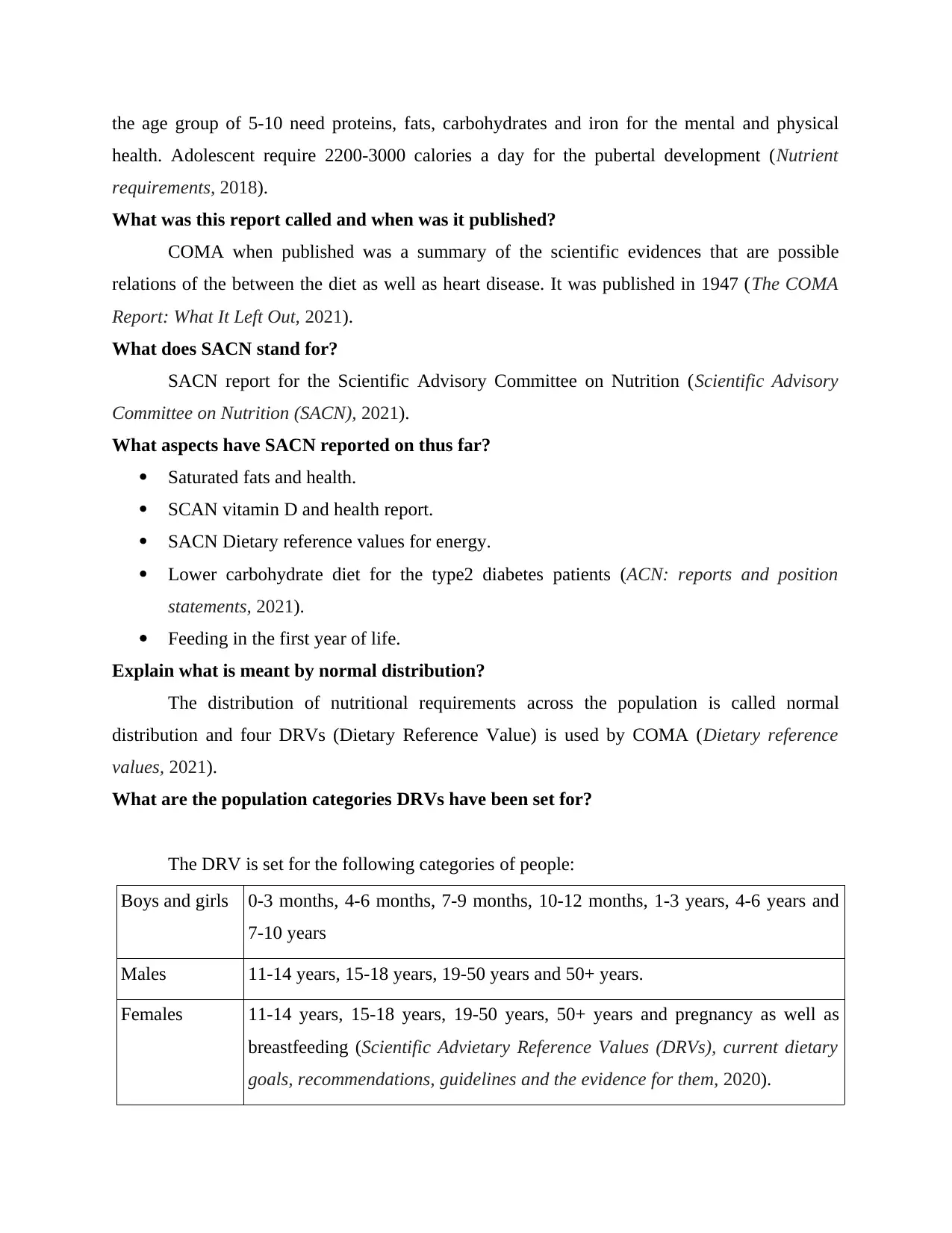
the age group of 5-10 need proteins, fats, carbohydrates and iron for the mental and physical
health. Adolescent require 2200-3000 calories a day for the pubertal development (Nutrient
requirements, 2018).
What was this report called and when was it published?
COMA when published was a summary of the scientific evidences that are possible
relations of the between the diet as well as heart disease. It was published in 1947 (The COMA
Report: What It Left Out, 2021).
What does SACN stand for?
SACN report for the Scientific Advisory Committee on Nutrition (Scientific Advisory
Committee on Nutrition (SACN), 2021).
What aspects have SACN reported on thus far?
Saturated fats and health.
SCAN vitamin D and health report.
SACN Dietary reference values for energy.
Lower carbohydrate diet for the type2 diabetes patients (ACN: reports and position
statements, 2021).
Feeding in the first year of life.
Explain what is meant by normal distribution?
The distribution of nutritional requirements across the population is called normal
distribution and four DRVs (Dietary Reference Value) is used by COMA (Dietary reference
values, 2021).
What are the population categories DRVs have been set for?
The DRV is set for the following categories of people:
Boys and girls 0-3 months, 4-6 months, 7-9 months, 10-12 months, 1-3 years, 4-6 years and
7-10 years
Males 11-14 years, 15-18 years, 19-50 years and 50+ years.
Females 11-14 years, 15-18 years, 19-50 years, 50+ years and pregnancy as well as
breastfeeding (Scientific Advietary Reference Values (DRVs), current dietary
goals, recommendations, guidelines and the evidence for them, 2020).
health. Adolescent require 2200-3000 calories a day for the pubertal development (Nutrient
requirements, 2018).
What was this report called and when was it published?
COMA when published was a summary of the scientific evidences that are possible
relations of the between the diet as well as heart disease. It was published in 1947 (The COMA
Report: What It Left Out, 2021).
What does SACN stand for?
SACN report for the Scientific Advisory Committee on Nutrition (Scientific Advisory
Committee on Nutrition (SACN), 2021).
What aspects have SACN reported on thus far?
Saturated fats and health.
SCAN vitamin D and health report.
SACN Dietary reference values for energy.
Lower carbohydrate diet for the type2 diabetes patients (ACN: reports and position
statements, 2021).
Feeding in the first year of life.
Explain what is meant by normal distribution?
The distribution of nutritional requirements across the population is called normal
distribution and four DRVs (Dietary Reference Value) is used by COMA (Dietary reference
values, 2021).
What are the population categories DRVs have been set for?
The DRV is set for the following categories of people:
Boys and girls 0-3 months, 4-6 months, 7-9 months, 10-12 months, 1-3 years, 4-6 years and
7-10 years
Males 11-14 years, 15-18 years, 19-50 years and 50+ years.
Females 11-14 years, 15-18 years, 19-50 years, 50+ years and pregnancy as well as
breastfeeding (Scientific Advietary Reference Values (DRVs), current dietary
goals, recommendations, guidelines and the evidence for them, 2020).
Paraphrase This Document
Need a fresh take? Get an instant paraphrase of this document with our AI Paraphraser
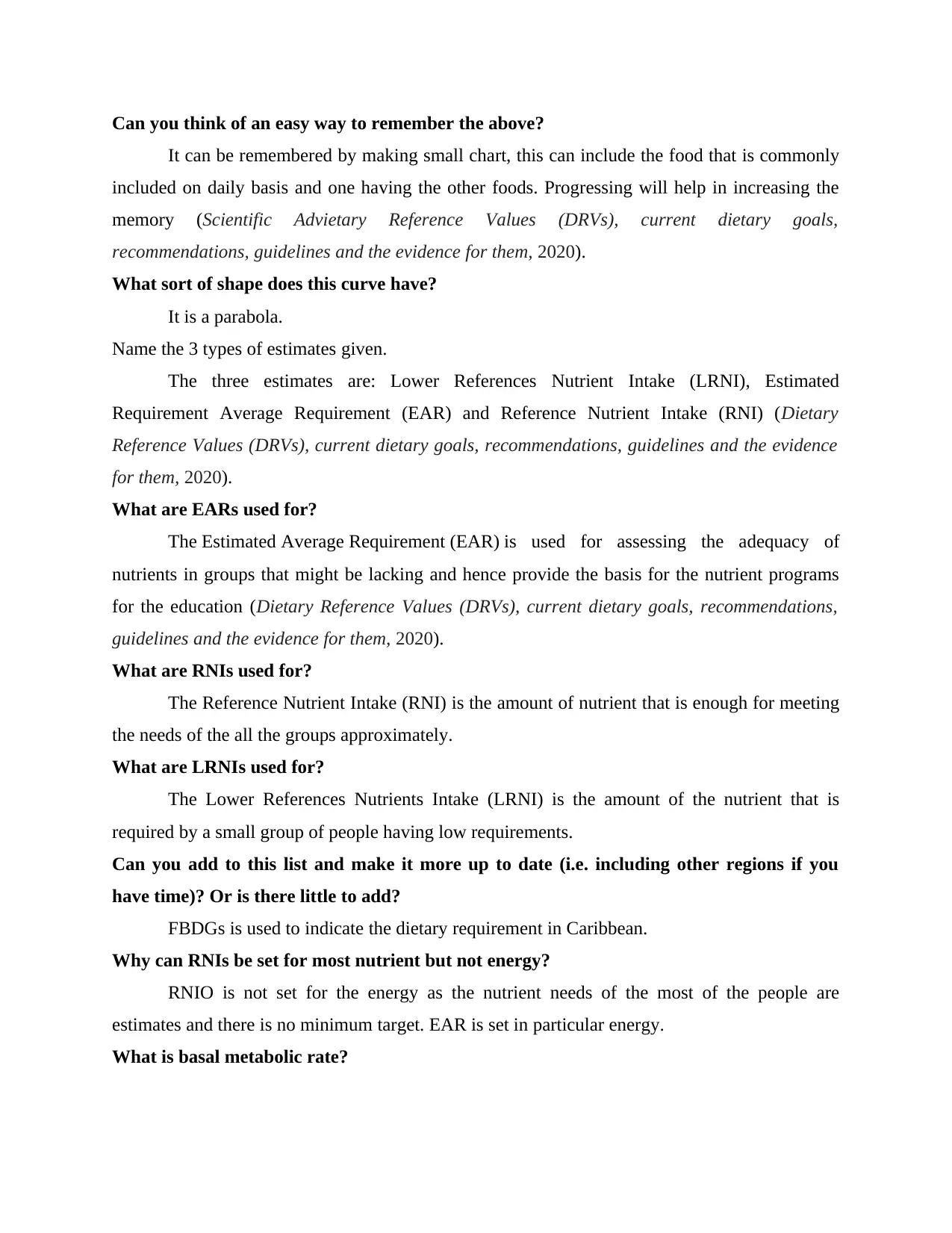
Can you think of an easy way to remember the above?
It can be remembered by making small chart, this can include the food that is commonly
included on daily basis and one having the other foods. Progressing will help in increasing the
memory (Scientific Advietary Reference Values (DRVs), current dietary goals,
recommendations, guidelines and the evidence for them, 2020).
What sort of shape does this curve have?
It is a parabola.
Name the 3 types of estimates given.
The three estimates are: Lower References Nutrient Intake (LRNI), Estimated
Requirement Average Requirement (EAR) and Reference Nutrient Intake (RNI) (Dietary
Reference Values (DRVs), current dietary goals, recommendations, guidelines and the evidence
for them, 2020).
What are EARs used for?
The Estimated Average Requirement (EAR) is used for assessing the adequacy of
nutrients in groups that might be lacking and hence provide the basis for the nutrient programs
for the education (Dietary Reference Values (DRVs), current dietary goals, recommendations,
guidelines and the evidence for them, 2020).
What are RNIs used for?
The Reference Nutrient Intake (RNI) is the amount of nutrient that is enough for meeting
the needs of the all the groups approximately.
What are LRNIs used for?
The Lower References Nutrients Intake (LRNI) is the amount of the nutrient that is
required by a small group of people having low requirements.
Can you add to this list and make it more up to date (i.e. including other regions if you
have time)? Or is there little to add?
FBDGs is used to indicate the dietary requirement in Caribbean.
Why can RNIs be set for most nutrient but not energy?
RNIO is not set for the energy as the nutrient needs of the most of the people are
estimates and there is no minimum target. EAR is set in particular energy.
What is basal metabolic rate?
It can be remembered by making small chart, this can include the food that is commonly
included on daily basis and one having the other foods. Progressing will help in increasing the
memory (Scientific Advietary Reference Values (DRVs), current dietary goals,
recommendations, guidelines and the evidence for them, 2020).
What sort of shape does this curve have?
It is a parabola.
Name the 3 types of estimates given.
The three estimates are: Lower References Nutrient Intake (LRNI), Estimated
Requirement Average Requirement (EAR) and Reference Nutrient Intake (RNI) (Dietary
Reference Values (DRVs), current dietary goals, recommendations, guidelines and the evidence
for them, 2020).
What are EARs used for?
The Estimated Average Requirement (EAR) is used for assessing the adequacy of
nutrients in groups that might be lacking and hence provide the basis for the nutrient programs
for the education (Dietary Reference Values (DRVs), current dietary goals, recommendations,
guidelines and the evidence for them, 2020).
What are RNIs used for?
The Reference Nutrient Intake (RNI) is the amount of nutrient that is enough for meeting
the needs of the all the groups approximately.
What are LRNIs used for?
The Lower References Nutrients Intake (LRNI) is the amount of the nutrient that is
required by a small group of people having low requirements.
Can you add to this list and make it more up to date (i.e. including other regions if you
have time)? Or is there little to add?
FBDGs is used to indicate the dietary requirement in Caribbean.
Why can RNIs be set for most nutrient but not energy?
RNIO is not set for the energy as the nutrient needs of the most of the people are
estimates and there is no minimum target. EAR is set in particular energy.
What is basal metabolic rate?
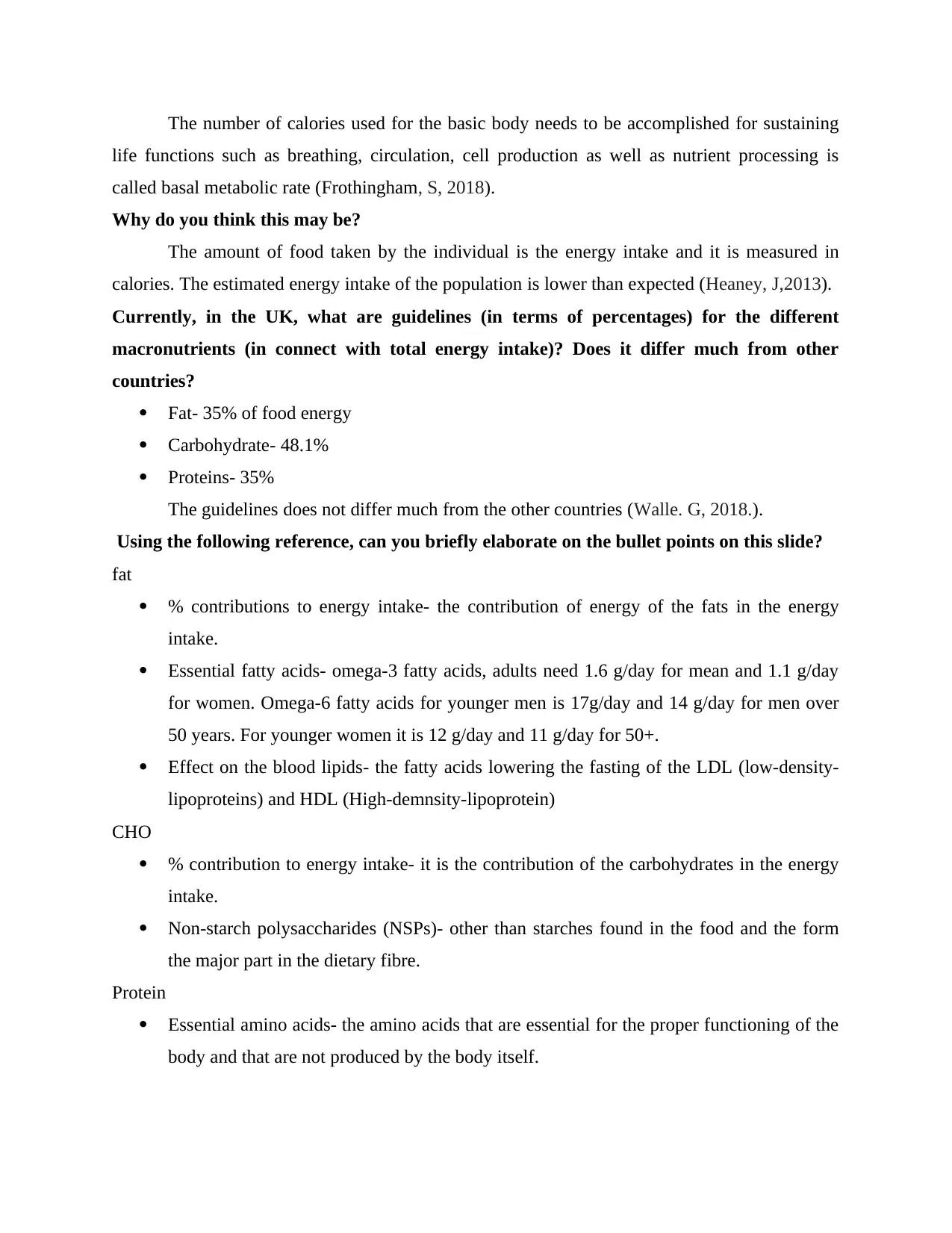
The number of calories used for the basic body needs to be accomplished for sustaining
life functions such as breathing, circulation, cell production as well as nutrient processing is
called basal metabolic rate (Frothingham, S, 2018).
Why do you think this may be?
The amount of food taken by the individual is the energy intake and it is measured in
calories. The estimated energy intake of the population is lower than expected (Heaney, J,2013).
Currently, in the UK, what are guidelines (in terms of percentages) for the different
macronutrients (in connect with total energy intake)? Does it differ much from other
countries?
Fat- 35% of food energy
Carbohydrate- 48.1%
Proteins- 35%
The guidelines does not differ much from the other countries (Walle. G, 2018.).
Using the following reference, can you briefly elaborate on the bullet points on this slide?
fat
% contributions to energy intake- the contribution of energy of the fats in the energy
intake.
Essential fatty acids- omega-3 fatty acids, adults need 1.6 g/day for mean and 1.1 g/day
for women. Omega-6 fatty acids for younger men is 17g/day and 14 g/day for men over
50 years. For younger women it is 12 g/day and 11 g/day for 50+.
Effect on the blood lipids- the fatty acids lowering the fasting of the LDL (low-density-
lipoproteins) and HDL (High-demnsity-lipoprotein)
CHO
% contribution to energy intake- it is the contribution of the carbohydrates in the energy
intake.
Non-starch polysaccharides (NSPs)- other than starches found in the food and the form
the major part in the dietary fibre.
Protein
Essential amino acids- the amino acids that are essential for the proper functioning of the
body and that are not produced by the body itself.
life functions such as breathing, circulation, cell production as well as nutrient processing is
called basal metabolic rate (Frothingham, S, 2018).
Why do you think this may be?
The amount of food taken by the individual is the energy intake and it is measured in
calories. The estimated energy intake of the population is lower than expected (Heaney, J,2013).
Currently, in the UK, what are guidelines (in terms of percentages) for the different
macronutrients (in connect with total energy intake)? Does it differ much from other
countries?
Fat- 35% of food energy
Carbohydrate- 48.1%
Proteins- 35%
The guidelines does not differ much from the other countries (Walle. G, 2018.).
Using the following reference, can you briefly elaborate on the bullet points on this slide?
fat
% contributions to energy intake- the contribution of energy of the fats in the energy
intake.
Essential fatty acids- omega-3 fatty acids, adults need 1.6 g/day for mean and 1.1 g/day
for women. Omega-6 fatty acids for younger men is 17g/day and 14 g/day for men over
50 years. For younger women it is 12 g/day and 11 g/day for 50+.
Effect on the blood lipids- the fatty acids lowering the fasting of the LDL (low-density-
lipoproteins) and HDL (High-demnsity-lipoprotein)
CHO
% contribution to energy intake- it is the contribution of the carbohydrates in the energy
intake.
Non-starch polysaccharides (NSPs)- other than starches found in the food and the form
the major part in the dietary fibre.
Protein
Essential amino acids- the amino acids that are essential for the proper functioning of the
body and that are not produced by the body itself.
⊘ This is a preview!⊘
Do you want full access?
Subscribe today to unlock all pages.

Trusted by 1+ million students worldwide
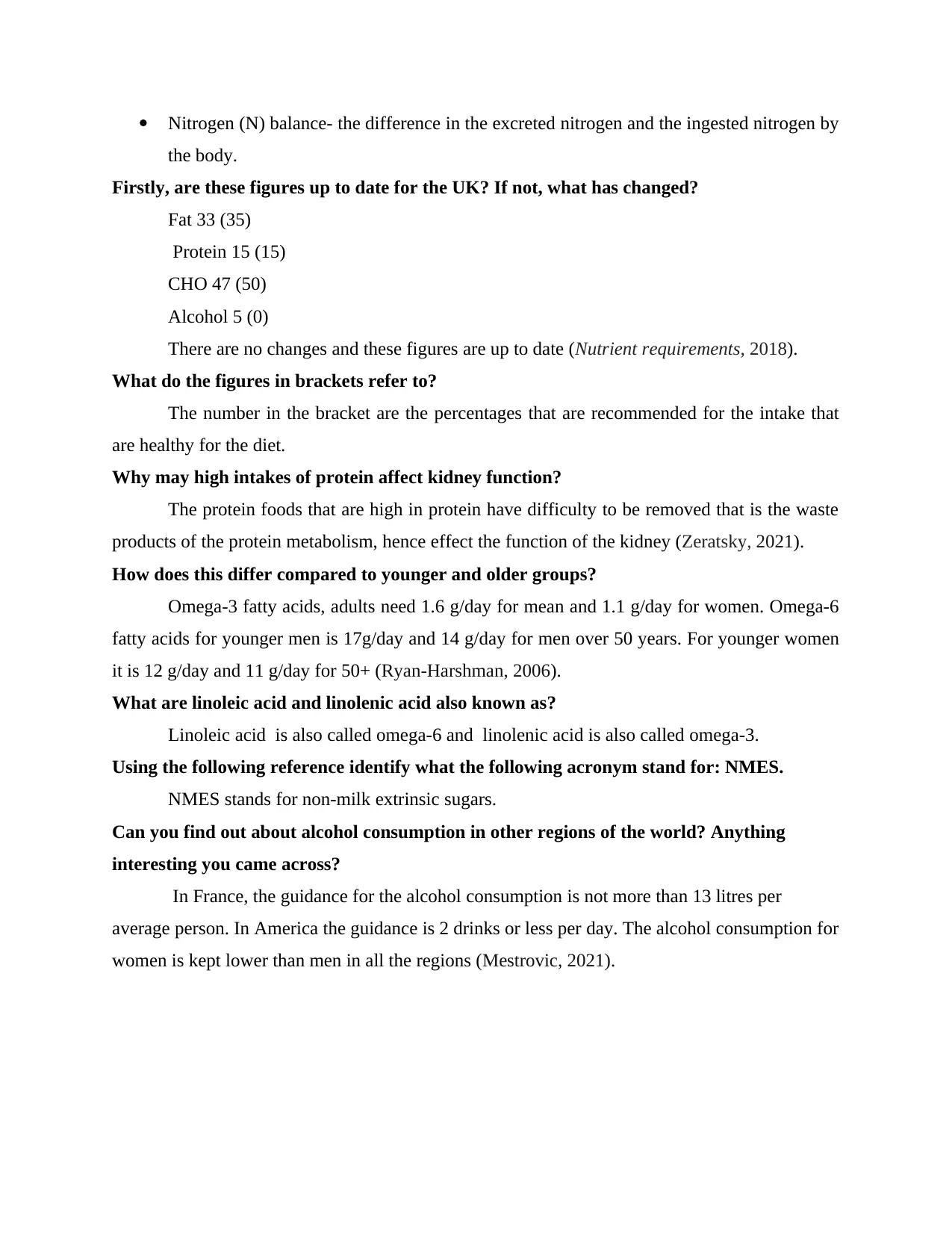
Nitrogen (N) balance- the difference in the excreted nitrogen and the ingested nitrogen by
the body.
Firstly, are these figures up to date for the UK? If not, what has changed?
Fat 33 (35)
Protein 15 (15)
CHO 47 (50)
Alcohol 5 (0)
There are no changes and these figures are up to date (Nutrient requirements, 2018).
What do the figures in brackets refer to?
The number in the bracket are the percentages that are recommended for the intake that
are healthy for the diet.
Why may high intakes of protein affect kidney function?
The protein foods that are high in protein have difficulty to be removed that is the waste
products of the protein metabolism, hence effect the function of the kidney (Zeratsky, 2021).
How does this differ compared to younger and older groups?
Omega-3 fatty acids, adults need 1.6 g/day for mean and 1.1 g/day for women. Omega-6
fatty acids for younger men is 17g/day and 14 g/day for men over 50 years. For younger women
it is 12 g/day and 11 g/day for 50+ (Ryan-Harshman, 2006).
What are linoleic acid and linolenic acid also known as?
Linoleic acid is also called omega-6 and linolenic acid is also called omega-3.
Using the following reference identify what the following acronym stand for: NMES.
NMES stands for non-milk extrinsic sugars.
Can you find out about alcohol consumption in other regions of the world? Anything
interesting you came across?
In France, the guidance for the alcohol consumption is not more than 13 litres per
average person. In America the guidance is 2 drinks or less per day. The alcohol consumption for
women is kept lower than men in all the regions (Mestrovic, 2021).
the body.
Firstly, are these figures up to date for the UK? If not, what has changed?
Fat 33 (35)
Protein 15 (15)
CHO 47 (50)
Alcohol 5 (0)
There are no changes and these figures are up to date (Nutrient requirements, 2018).
What do the figures in brackets refer to?
The number in the bracket are the percentages that are recommended for the intake that
are healthy for the diet.
Why may high intakes of protein affect kidney function?
The protein foods that are high in protein have difficulty to be removed that is the waste
products of the protein metabolism, hence effect the function of the kidney (Zeratsky, 2021).
How does this differ compared to younger and older groups?
Omega-3 fatty acids, adults need 1.6 g/day for mean and 1.1 g/day for women. Omega-6
fatty acids for younger men is 17g/day and 14 g/day for men over 50 years. For younger women
it is 12 g/day and 11 g/day for 50+ (Ryan-Harshman, 2006).
What are linoleic acid and linolenic acid also known as?
Linoleic acid is also called omega-6 and linolenic acid is also called omega-3.
Using the following reference identify what the following acronym stand for: NMES.
NMES stands for non-milk extrinsic sugars.
Can you find out about alcohol consumption in other regions of the world? Anything
interesting you came across?
In France, the guidance for the alcohol consumption is not more than 13 litres per
average person. In America the guidance is 2 drinks or less per day. The alcohol consumption for
women is kept lower than men in all the regions (Mestrovic, 2021).
Paraphrase This Document
Need a fresh take? Get an instant paraphrase of this document with our AI Paraphraser

CONCLUSION
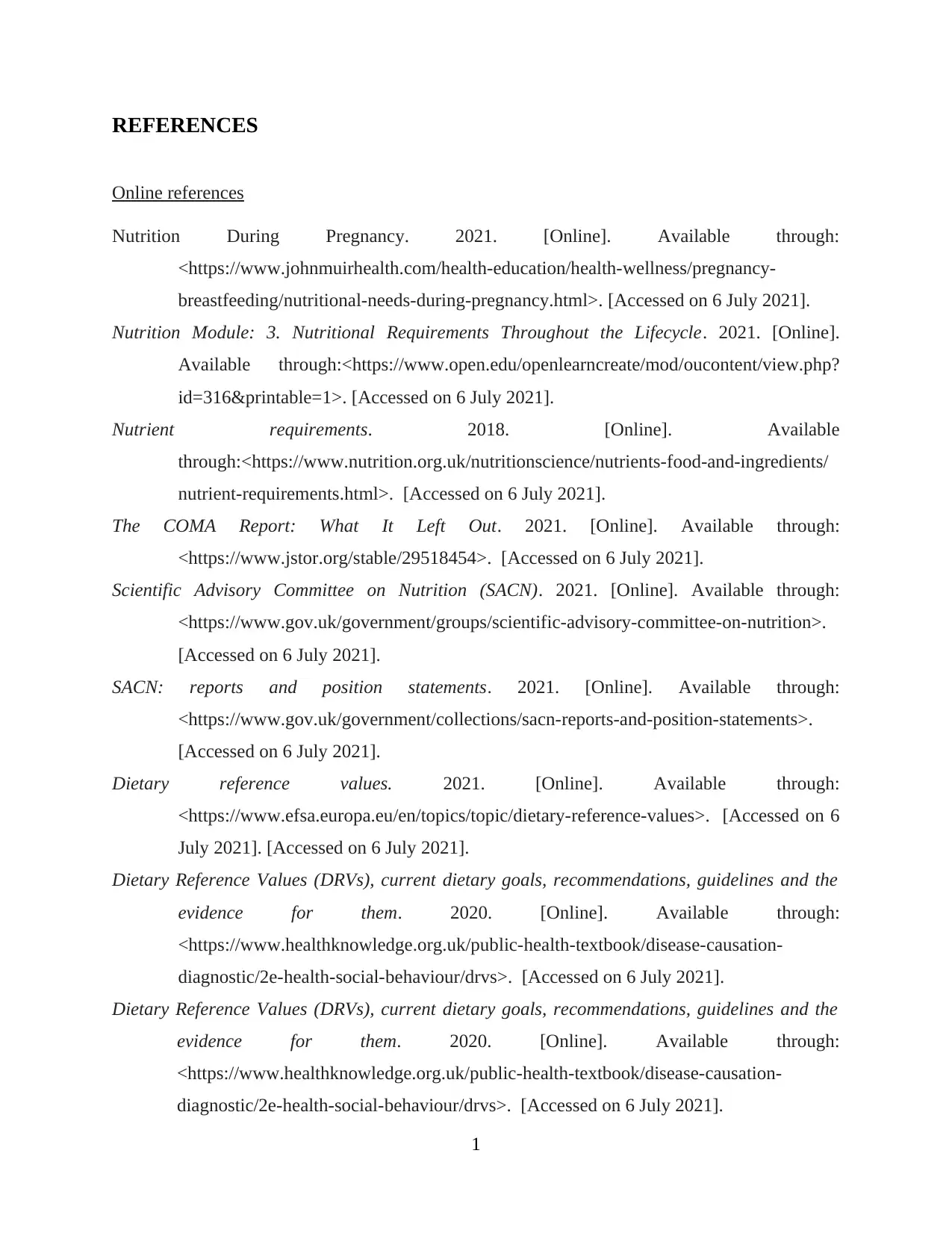
REFERENCES
Online references
Nutrition During Pregnancy. 2021. [Online]. Available through:
<https://www.johnmuirhealth.com/health-education/health-wellness/pregnancy-
breastfeeding/nutritional-needs-during-pregnancy.html>. [Accessed on 6 July 2021].
Nutrition Module: 3. Nutritional Requirements Throughout the Lifecycle. 2021. [Online].
Available through:<https://www.open.edu/openlearncreate/mod/oucontent/view.php?
id=316&printable=1>. [Accessed on 6 July 2021].
Nutrient requirements. 2018. [Online]. Available
through:<https://www.nutrition.org.uk/nutritionscience/nutrients-food-and-ingredients/
nutrient-requirements.html>. [Accessed on 6 July 2021].
The COMA Report: What It Left Out. 2021. [Online]. Available through:
<https://www.jstor.org/stable/29518454>. [Accessed on 6 July 2021].
Scientific Advisory Committee on Nutrition (SACN). 2021. [Online]. Available through:
<https://www.gov.uk/government/groups/scientific-advisory-committee-on-nutrition>.
[Accessed on 6 July 2021].
SACN: reports and position statements. 2021. [Online]. Available through:
<https://www.gov.uk/government/collections/sacn-reports-and-position-statements>.
[Accessed on 6 July 2021].
Dietary reference values. 2021. [Online]. Available through:
<https://www.efsa.europa.eu/en/topics/topic/dietary-reference-values>. [Accessed on 6
July 2021]. [Accessed on 6 July 2021].
Dietary Reference Values (DRVs), current dietary goals, recommendations, guidelines and the
evidence for them. 2020. [Online]. Available through:
<https://www.healthknowledge.org.uk/public-health-textbook/disease-causation-
diagnostic/2e-health-social-behaviour/drvs>. [Accessed on 6 July 2021].
Dietary Reference Values (DRVs), current dietary goals, recommendations, guidelines and the
evidence for them. 2020. [Online]. Available through:
<https://www.healthknowledge.org.uk/public-health-textbook/disease-causation-
diagnostic/2e-health-social-behaviour/drvs>. [Accessed on 6 July 2021].
1
Online references
Nutrition During Pregnancy. 2021. [Online]. Available through:
<https://www.johnmuirhealth.com/health-education/health-wellness/pregnancy-
breastfeeding/nutritional-needs-during-pregnancy.html>. [Accessed on 6 July 2021].
Nutrition Module: 3. Nutritional Requirements Throughout the Lifecycle. 2021. [Online].
Available through:<https://www.open.edu/openlearncreate/mod/oucontent/view.php?
id=316&printable=1>. [Accessed on 6 July 2021].
Nutrient requirements. 2018. [Online]. Available
through:<https://www.nutrition.org.uk/nutritionscience/nutrients-food-and-ingredients/
nutrient-requirements.html>. [Accessed on 6 July 2021].
The COMA Report: What It Left Out. 2021. [Online]. Available through:
<https://www.jstor.org/stable/29518454>. [Accessed on 6 July 2021].
Scientific Advisory Committee on Nutrition (SACN). 2021. [Online]. Available through:
<https://www.gov.uk/government/groups/scientific-advisory-committee-on-nutrition>.
[Accessed on 6 July 2021].
SACN: reports and position statements. 2021. [Online]. Available through:
<https://www.gov.uk/government/collections/sacn-reports-and-position-statements>.
[Accessed on 6 July 2021].
Dietary reference values. 2021. [Online]. Available through:
<https://www.efsa.europa.eu/en/topics/topic/dietary-reference-values>. [Accessed on 6
July 2021]. [Accessed on 6 July 2021].
Dietary Reference Values (DRVs), current dietary goals, recommendations, guidelines and the
evidence for them. 2020. [Online]. Available through:
<https://www.healthknowledge.org.uk/public-health-textbook/disease-causation-
diagnostic/2e-health-social-behaviour/drvs>. [Accessed on 6 July 2021].
Dietary Reference Values (DRVs), current dietary goals, recommendations, guidelines and the
evidence for them. 2020. [Online]. Available through:
<https://www.healthknowledge.org.uk/public-health-textbook/disease-causation-
diagnostic/2e-health-social-behaviour/drvs>. [Accessed on 6 July 2021].
1
⊘ This is a preview!⊘
Do you want full access?
Subscribe today to unlock all pages.

Trusted by 1+ million students worldwide
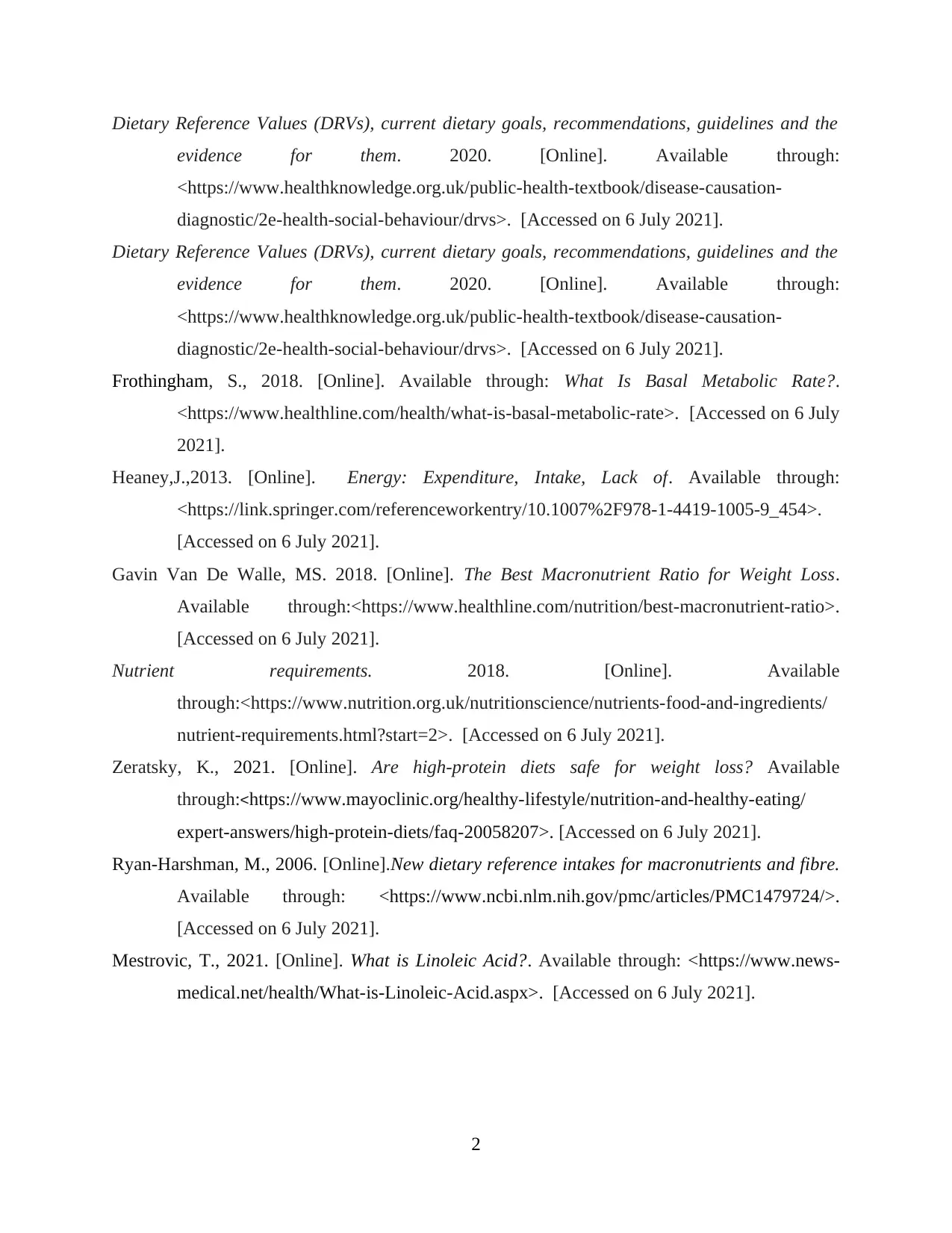
Dietary Reference Values (DRVs), current dietary goals, recommendations, guidelines and the
evidence for them. 2020. [Online]. Available through:
<https://www.healthknowledge.org.uk/public-health-textbook/disease-causation-
diagnostic/2e-health-social-behaviour/drvs>. [Accessed on 6 July 2021].
Dietary Reference Values (DRVs), current dietary goals, recommendations, guidelines and the
evidence for them. 2020. [Online]. Available through:
<https://www.healthknowledge.org.uk/public-health-textbook/disease-causation-
diagnostic/2e-health-social-behaviour/drvs>. [Accessed on 6 July 2021].
Frothingham, S., 2018. [Online]. Available through: What Is Basal Metabolic Rate?.
<https://www.healthline.com/health/what-is-basal-metabolic-rate>. [Accessed on 6 July
2021].
Heaney,J.,2013. [Online]. Energy: Expenditure, Intake, Lack of. Available through:
<https://link.springer.com/referenceworkentry/10.1007%2F978-1-4419-1005-9_454>.
[Accessed on 6 July 2021].
Gavin Van De Walle, MS. 2018. [Online]. The Best Macronutrient Ratio for Weight Loss.
Available through:<https://www.healthline.com/nutrition/best-macronutrient-ratio>.
[Accessed on 6 July 2021].
Nutrient requirements. 2018. [Online]. Available
through:<https://www.nutrition.org.uk/nutritionscience/nutrients-food-and-ingredients/
nutrient-requirements.html?start=2>. [Accessed on 6 July 2021].
Zeratsky, K., 2021. [Online]. Are high-protein diets safe for weight loss? Available
through:<https://www.mayoclinic.org/healthy-lifestyle/nutrition-and-healthy-eating/
expert-answers/high-protein-diets/faq-20058207>. [Accessed on 6 July 2021].
Ryan-Harshman, M., 2006. [Online].New dietary reference intakes for macronutrients and fibre.
Available through: <https://www.ncbi.nlm.nih.gov/pmc/articles/PMC1479724/>.
[Accessed on 6 July 2021].
Mestrovic, T., 2021. [Online]. What is Linoleic Acid?. Available through: <https://www.news-
medical.net/health/What-is-Linoleic-Acid.aspx>. [Accessed on 6 July 2021].
2
evidence for them. 2020. [Online]. Available through:
<https://www.healthknowledge.org.uk/public-health-textbook/disease-causation-
diagnostic/2e-health-social-behaviour/drvs>. [Accessed on 6 July 2021].
Dietary Reference Values (DRVs), current dietary goals, recommendations, guidelines and the
evidence for them. 2020. [Online]. Available through:
<https://www.healthknowledge.org.uk/public-health-textbook/disease-causation-
diagnostic/2e-health-social-behaviour/drvs>. [Accessed on 6 July 2021].
Frothingham, S., 2018. [Online]. Available through: What Is Basal Metabolic Rate?.
<https://www.healthline.com/health/what-is-basal-metabolic-rate>. [Accessed on 6 July
2021].
Heaney,J.,2013. [Online]. Energy: Expenditure, Intake, Lack of. Available through:
<https://link.springer.com/referenceworkentry/10.1007%2F978-1-4419-1005-9_454>.
[Accessed on 6 July 2021].
Gavin Van De Walle, MS. 2018. [Online]. The Best Macronutrient Ratio for Weight Loss.
Available through:<https://www.healthline.com/nutrition/best-macronutrient-ratio>.
[Accessed on 6 July 2021].
Nutrient requirements. 2018. [Online]. Available
through:<https://www.nutrition.org.uk/nutritionscience/nutrients-food-and-ingredients/
nutrient-requirements.html?start=2>. [Accessed on 6 July 2021].
Zeratsky, K., 2021. [Online]. Are high-protein diets safe for weight loss? Available
through:<https://www.mayoclinic.org/healthy-lifestyle/nutrition-and-healthy-eating/
expert-answers/high-protein-diets/faq-20058207>. [Accessed on 6 July 2021].
Ryan-Harshman, M., 2006. [Online].New dietary reference intakes for macronutrients and fibre.
Available through: <https://www.ncbi.nlm.nih.gov/pmc/articles/PMC1479724/>.
[Accessed on 6 July 2021].
Mestrovic, T., 2021. [Online]. What is Linoleic Acid?. Available through: <https://www.news-
medical.net/health/What-is-Linoleic-Acid.aspx>. [Accessed on 6 July 2021].
2
Paraphrase This Document
Need a fresh take? Get an instant paraphrase of this document with our AI Paraphraser

3

4
⊘ This is a preview!⊘
Do you want full access?
Subscribe today to unlock all pages.

Trusted by 1+ million students worldwide
1 out of 12
Related Documents
Your All-in-One AI-Powered Toolkit for Academic Success.
+13062052269
info@desklib.com
Available 24*7 on WhatsApp / Email
![[object Object]](/_next/static/media/star-bottom.7253800d.svg)
Unlock your academic potential
Copyright © 2020–2025 A2Z Services. All Rights Reserved. Developed and managed by ZUCOL.





